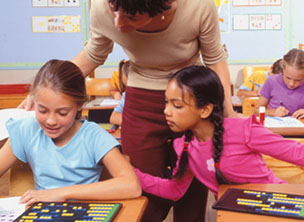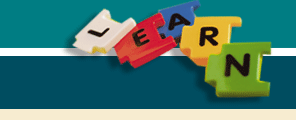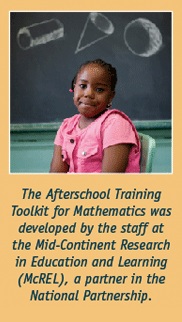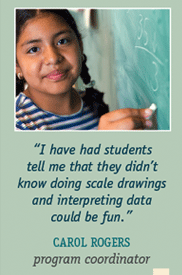 |
|
 |
 |
|
||||
 |
“Key Ideas” for Mathematics Enrichment in Afterschool “Long division is impossible!” If your afterschool program offers mathematics enrichment, you have undoubtedly heard comments like this one. While enticing a student who dislikes math to devote another hour to the subject in afterschool is hardly a task any instructor would enjoy, an afterschool program can be an ideal setting to help students become math lovers. As we discuss math in this issue of AfterWords, we are focusing on what we call “key ideas” in math.1 These are strategies in afterschool mathematics enrichment that can help your students become better at math and perhaps enjoy it more, too. Encourage problem solving. One afterschool instructor we talked to realized that her students were frustrated spending their afterschool time struggling through worksheets as they tried to learn to multiply and divide fractions. Instead she put them to work in the kitchen, asking them to make a quadruple batch of cookies and reduce a brownie recipe by half. The students had to use their problem-solving skills to determine how they would multiply and divide fractions. Develop and Support Math Talk. When they worked on their recipes, few of the students knew how to determine the correct measurements, they talked about it. By discussing the problems in their own words, students were able to build on what they already knew and better understand mathematical ideas like fractions. Emphasize Working Together. Many of us who have prepared a meal with a friend or two can say that the company often makes the task more fun. The same is true for the students learning about math in the kitchen. As it turns out, research indicates that the students probably learned more about multiplying and dividing fractions by working in a group than they would have working alone. 1 Key ideas in math are some of the resources provided in the online Afterschool Training Toolkit for Mathematics, whose contents were developed by the staff at the Mid-Continent Research in Education and Learning (McREL), a partner in the National Partnership. |
|

PASS Afterschool Program
|
|
|
Questions or comments should be directed to: Laura Shankland |
Copyright © 2007 by SEDL . This newsletter was produced in whole or in part with funds from the U.S. Department of Education under contract number ED-01-CO-0057/0001. You are welcome to reproduce issues of AfterWords and distribute copies at no cost to recipients. Please credit SEDL as publisher. Link to PDF versions of AfterWords is available here. For additional uses, please fill out and submit a copyright request form. |






